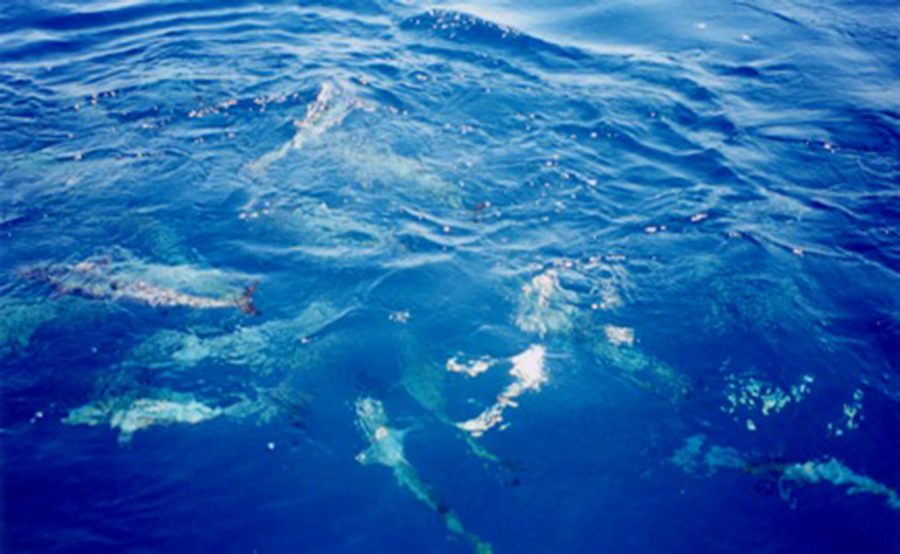SOUTH FLORIDA TUNAS ON THE FLY: CHUM THEM UP
Zac Grossman
There are three very easily accessible species of tuna in south Florida and the Keys that just love flies. They are the black fin tuna, the skipjack tuna, and the bonito. The bonito (as they are called in Florida) are known by other names elsewhere. They are one and the same as the false albacore and little tunny.
They are the easiest to find, so I’ll discuss them first. They are here all year long; most commonly found in 60 to 200 feet of water and at times will follow and harass bait in water as shallow as 15 feet where many are even caught from piers.
From early summer until early fall they are often marauding bait pods on reefs and wrecks. For these reasons, they are targeted by half day head boats, called drift boats down here. Multiple bent rods are often the norm and this is without chumming!
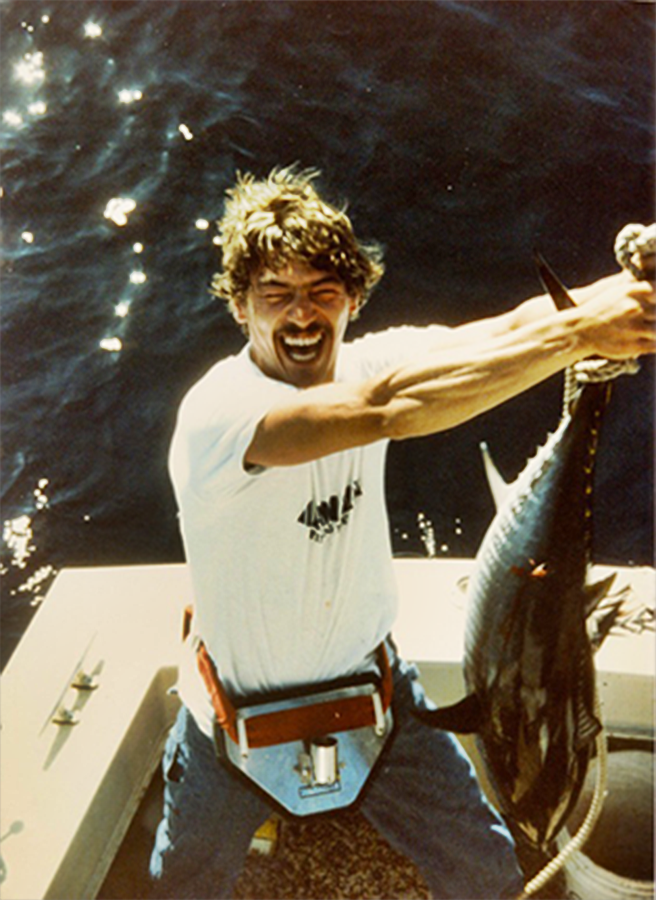 For fly anglers to cash in on this you only need a boat, either yours or a charter (fly casting would not be allowed on a head boat). Drive out to the depth where all the head boats are fishing (from Spring until Winter), and start chumming with a block of frozen bunker in a chum bag. When you see the silver flashes in the slick, start casting. You can use a sinking line with almost any baitfish imitation (you’re trying to mimic small fish feeding on the chum bits), a floating line with the same flies, or most enjoyably small poppers (white on the belly, blue or green on top, silver metal flake all over). The strike is electrifying and the fight incredible. Perhaps the best part is that these fish are so thick down here that losing one only means rigging up again and expecting to hook another in mere minutes.
For fly anglers to cash in on this you only need a boat, either yours or a charter (fly casting would not be allowed on a head boat). Drive out to the depth where all the head boats are fishing (from Spring until Winter), and start chumming with a block of frozen bunker in a chum bag. When you see the silver flashes in the slick, start casting. You can use a sinking line with almost any baitfish imitation (you’re trying to mimic small fish feeding on the chum bits), a floating line with the same flies, or most enjoyably small poppers (white on the belly, blue or green on top, silver metal flake all over). The strike is electrifying and the fight incredible. Perhaps the best part is that these fish are so thick down here that losing one only means rigging up again and expecting to hook another in mere minutes.
Bonito are often teen sized and are ferocious fighters. In the north (New England through New Jersey) they are the most highly prized species of the awesome fall runs. While the waters are being churned by huge bluefish and striped bass that are easy to target up there, fly anglers (and spin casters) race around chasing fast moving flocks of birds that indicate where the false albacore have pushed a school of bait to the surface. While bonito can be found virtually everywhere (both Florida coasts and the Keys), the blackfin tuna is targeted in specific locations, being more of a pleasant surprise when caught elsewhere. This member of the tuna family is highly prized because of its size and its taste. Its fight is much like that of the bonito but they often weigh two or three times as much and that sure makes a difference. Skipjack tuna are often found among the blackfins but not really targeted specifically.
Of the locations associated with blackfins, I’ll discuss the “humps” off Islamorada and Marathon keys first. Fishing is done the same way at both of these spots where the dramatic rise from the bottom coupled with the strong currents create an upwelling that both attracts and disorients bait; the ideal feeding place for predators including blackfin tuna, skipjack tuna, bonito, dolphin, amberjack, wahoo, billfish, and sharks (which also like the taste of all the above and can become a nuisance).
The standard methods of fishing the humps are trolling and drifting. Drifting is obviously the way to fly fish and again chumming is the answer. The idea is to get the tuna on top and reckless as they compete with each other.
If you are going on a charter, expect the captain to stop and net pilchards. If in your own boat be prepared to do the same. The best chum is LIVE pilchards and this means a top notch live well system because the norm is to head out there with about 1,000 of them. The boat is positioned to drift over the crown of the hump and live chum is tossed over the side, a dip net full at a time. You could blind cast with sinking lines as the baits will be trying to dive to supposed safety or you could wait until the steady stream of baits creates a trail for the tunas to follow as they head to the surface. Once they are there, tossing over baits is like feeding pigeons; every handful creates a frenzy of competition for the “crumbs”.
At this point all you need do is cast a fly into the melee to hook up. In actuality, once your fly hits the water all you have to do is wait for the hit as everything in the water that is either white or shiny at this point will be tasted before some other fish grabs it. If you set the hook before the scam is realized, then you will be tied to a member of the speediest species in the ocean.
Saltwater fly anglers have a hard time just standing there doing nothing and they also have a hard time just fishing a simple white streamer fly when there are hundreds of beautiful flies to choose from. If they tie their own, then it is downright impossible. In that case choose something that looks like a pilchard and strip away.
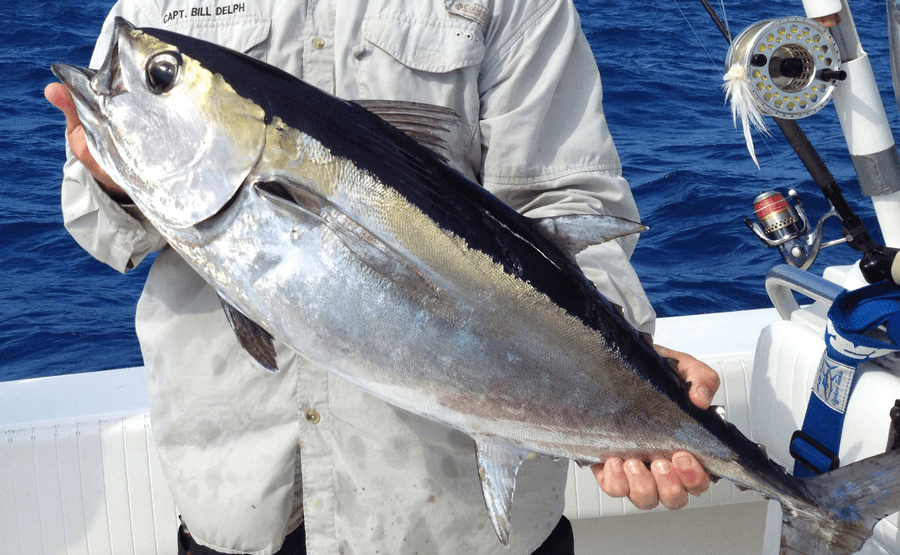
Courtesy Bill Delph – Delph FIshing
The duration of the fight, and it will be lengthy, depends on the size of the fish.
All three species are fast enough to test you and your tackle. Try to strip out only enough line to land your fly where the tunas are busting. The more line on the deck from either having pulled out more than you need or from having stripped the fly in, the more you have to concentrate
on getting that line through the guides without a hangup. A knot, a loop, anything that hangs up for even a fraction of a second means a snapped leader at the speeds these fish generate.
Tunas have small teeth, almost like large grit sandpaper so no wire is necessary. The frenzy allows you to use a mono shock tippet if long battles are wearing through your actual tippet.
At the humps all three species are likely to appear in your chum. The most desired blackfins tend to hang back and appear much, much darker than the others and much fatter. Cast to the outer edge of the frenzy and hope for the best. Finally there is bycatch chumming. This works where commercial draggers operate. When they haul back and then cull the catch huge schools of tuna rise to the surface and gorge themselves. Fishing behind a dragger engaged in this can be very tricky and even dangerous so the best thing to do is simulate.
The schools of tuna and bonito know there is no percentage in swimming all over the place when all they have to do is hang out near the draggers, even when they are not dragging because once they do start, a smorgasbord is not too far into the future.
In the Keys, it is the shrimp boats that the tuna hang with.
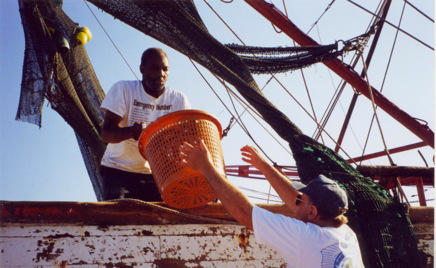 They drag all night and the crews sleep during the day, at anchor. Charter captains know approximately where the fleet is, and if you plan to use your own boat you need to find out from local tackle shops, mates, or even captains, if you can convince them to share the information. The fleet will be in the Gulf and usually about 50 miles out. Mind the weather, that’s a long way from home. What might be an hour ride out can seem like an eternity when coming back in a squall.
They drag all night and the crews sleep during the day, at anchor. Charter captains know approximately where the fleet is, and if you plan to use your own boat you need to find out from local tackle shops, mates, or even captains, if you can convince them to share the information. The fleet will be in the Gulf and usually about 50 miles out. Mind the weather, that’s a long way from home. What might be an hour ride out can seem like an eternity when coming back in a squall.
Getting chum for this kind of fishing means pulling up to a dragger and “buying” a few bushels of the bycatch they would normally just shovel overboard. When the weather is good, the draggers shovel less and put aside more knowing this will happen. I have seen the “price” vary from a couple of twenties to a few six packs of Dr. Pepper and a local newspaper.
Charter captains know which boats are where and what to bring; hard earned local knowledge.
If doing this on your own, with a cooler full of bycatch (baitfish, mantis shrimp, puffers, shellfish, and such) position your boat about a hundred feet off the stern of an anchored shrimper.
Looking down into the emerald green water you will see nothing moving. Throw a couple of handfuls of bycatch and that will quickly change. If you see a mantis shrimp that is not lying there limp, but seems alive, DO NOT reach for it – they can open up the whole length of a finger in a millisecond. When a school rises to your chum, it will usually be both bonito and blackfins, about 10 to 1. There will be silver streaks crisscrossing in all directions and on the outskirts of the frenzy will be the darker,slower target you really want; the blackfin tuna. Throw any white streamer and let it sit and a bonito will inhale it almost immediately. Even a cast directed at the black fins will suffer this fate 9 out of 10 times.
It’s not so terrible; fighting a huge bonito will test your reel’s drag, your knots, your knuckles (if they get in the way of a wildly spinning reel handle), and your rod’s backbone as the fish goes into its final ploy. Blackfins will however make all the above even harder.
There is one trick that will increase your odds of getting a blackfin under these conditions, if you have the reflexes. A fly that closely imitates a puffer (brown and orange mostly) is the answer. Bonito generally will wolf down anything you throw over but they usually spit the puffers out. The blackfins love them. When spin fishing it takes nerves of steel as a dead puffer on the hook might be inhaled and spit out by a dozen bonito before a blackfin grabs it. The angler has to restrain from setting the hook until sure it is in the right mouth.
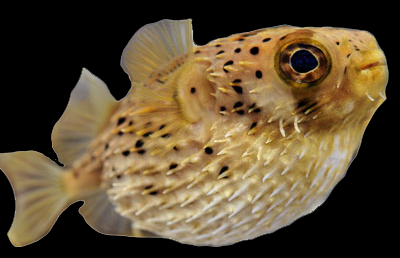 For the fly angler it is setting the hook in time, but not on the “wrong” fish. Use a puffer fly cast to the outskirts but remember that a bonito might speed up and taste it out there too. They will spit it out, but not because it tastes like a puffer; because it is not real. So the fly angler has to both resist striking back and try to keep some slack in the line so the fish doesn’t hook itself. You have to see the take to know who took it!
For the fly angler it is setting the hook in time, but not on the “wrong” fish. Use a puffer fly cast to the outskirts but remember that a bonito might speed up and taste it out there too. They will spit it out, but not because it tastes like a puffer; because it is not real. So the fly angler has to both resist striking back and try to keep some slack in the line so the fish doesn’t hook itself. You have to see the take to know who took it!
When a blackfin grabs the fly you have to set the hook immediately because they will also realize it is a fake rather than a tasty puffer. Again, if you hook a blackfin the fight will be amazing, enhanced by its size. Pace yourself and enjoy the fight.
BACK TO BLOG
 SUBSCRIBE TO READ MORE
SUBSCRIBE TO READ MORE
fly fishing magazine
tail fly fishing magazine

